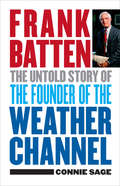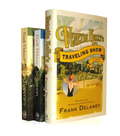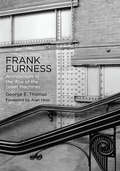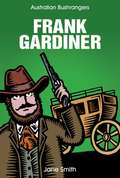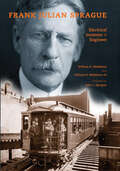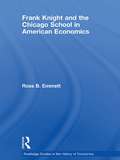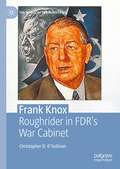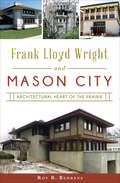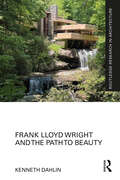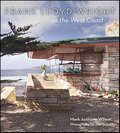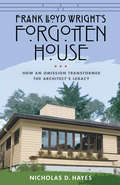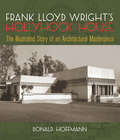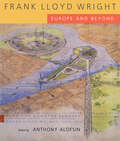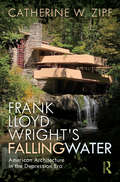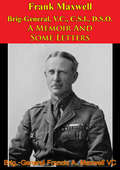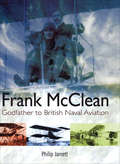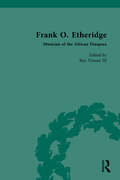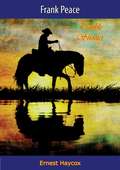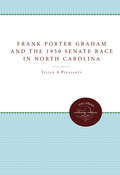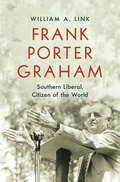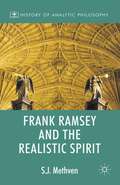- Table View
- List View
Frank Ankersmit's Lost Historical Cause: A Journey from Language to Experience (Routledge Approaches to History)
by Peter IckeThe contemporary Dutch historical theorist/philosopher Frank Ankersmit, an erstwhile advocate and promulgator of what has become known as "the linguistic turn" in historical theory, is very well known within the discipline. His early position with regard to the historical text is frequently discussed and evaluated today, and his writings on the subject are often cited. However, this former narrativist position, so robustly and effectively defended by Ankersmit in the past, has been progressively marginalized by Ankersmit himself as his current and radically different theoretical position, most fully expressed in his recent publication Sublime Historical Experience, now (for him) takes precedence. Yet, despite this radical shift in Ankersmit's position, this conspicuous "conversion" of an eminent prime mover in the field of mainstream language centred historical theory, there has been no comprehensive and sustained (investigative) critique of his various works taken in the whole. Consequently, there has until now been no close reading and analytical dissection of that whole, such that Ankersmit's overall trajectory of philosophical thought might be adequately discerned, and perhaps even explained. In short, there is a vacant space here, and the function of this book is, precisely, to fill that space.
Frank Batten: The Untold Story of the Founder of the Weather Channel
by Connie M. SageFrank Batten Sr. (1927-2009) created the Weather Channel in 1982, despite mocking by colleagues in the media that around-the-clock weather broadcasts would be as exciting as watching paint dry. The network, and later its companion website, Weather.com, became the largest private weather company in the world and an American cultural icon.Yet few have heard of Batten, a media pioneer whose Virginia newspaper was the only major daily to back school integration. At a time when American corporate greed was making headlines, without fanfare and limelight Batten built a media empire centered on honesty, integrity, and ethics.Starting out in his uncle's newspaper business in Norfolk, Virginia, as a reporter and advertising salesman, he assumed leadership of the Virginian-Pilot and Ledger-Star at the age of twenty-seven and grew Landmark Communications into a media powerhouse. He championed racial equality, a position not often taken in Virginia during the 1950s. His flagship newspaper, the Pilot, was the only daily paper in Virginia to back court-ordered school desegregation. He created two billion-dollar businesses and gave away more than $400 million to charity, nearly all of it to education. As chairman of the Associated Press from 1982 to 1987, he helped guide the news agency back on a sound financial footing. Batten also faced a tremendous personal challenge that would have sidelined many: he lost his vocal cords to cancer two years before starting the Weather Channel.This is the untold story of a man whose name few recognize, yet who helped change the face of the media in the twentieth century.
Frank Delaney's The Ireland Novels 3-Book Bundle
by Frank DelaneyThis convenient eBook package contains three novels of Ireland from New York Times bestselling author Frank Delaney: Tipperary, Shannon, and Venetia Kelly's Traveling Show. Tipperary:"My wooing began in passion, was defined by violence and circumscribed by land; all these elements molded my soul." So writes Charles O'Brien, the unforgettable hero of bestselling author Frank Delaney's extraordinary new novel--a sweeping epic of obsession, profound devotion, and compelling history involving a turbulent era that would shape modern Ireland. Shannon: In the summer of 1922, Robert Shannon, a Marine chaplain and a young American hero of the Great War, lands in Ireland. He still suffers from shell shock, and his mentor hopes that a journey Robert had always wanted to make--to find his family roots along the banks of the River Shannon--will restore his equilibrium and his vocation. But there is more to the story: On his return from the war, Robert had witnessed startling corruption in the Archdiocese of Boston. He has been sent to Ireland to secure his silence--permanently. As Robert faces the dangers of a strife-torn Ireland roiling in civil war, the nation's myths and people, its beliefs and traditions, unfurl healingly before him. And the River Shannon gives comfort to the young man who is inspired by the words of his mentor: "Find your soul and you'll live." Venetia Kelly's Traveling Show: "She sprang from the womb and waved to the crowd. Then smiled and took a bow." And so we first meet Venetia Kelly, the beguiling actress at the center of this new, spellbinding, and epic novel by Frank Delaney, the bestselling author of Ireland and Shannon. Teeming with intrigue, pathos, and humor, Venetia Kelly's Traveling Show explores two of Ireland's great national passions: theater and politics. Writing with his signature mastery and lyrical prose, Frank Delaney once again delivers an unforgettable story as big and boisterous as the people and events it chronicles. the woman he loves is twinned with his country's emergence as a nation. With storytelling as sweeping and dramatic as the land itself, myth, fact, and fiction are all woven together with the power of the great nineteenth-century novelists. Tipperary once again proves Frank Delaney's unrivaled mastery at bringing Irish history to life. Shannon: In the summer of 1922, Robert Shannon, a Marine chaplain and a young American hero of the Great War, lands in Ireland. He still suffers from shell shock, and his mentor hopes that a journey Robert had always wanted to make--to find his family roots along the banks of the River Shannon--will restore his equilibrium and his vocation. But there is more to the story: On his return from the war, Robert had witnessed startling corruption in the Archdiocese of Boston. He has been sent to Ireland to secure his silence--permanently. As Robert faces the dangers of a strife-torn Ireland roiling in civil war, the nation's myths and people, its beliefs and traditions, unfurl healingly before him. And the River Shannon gives comfort to the young man who is inspired by the words of his mentor: "Find your soul and you'll live." Venetia Kelly's Traveling Show: "She sprang from the womb and waved to the crowd. Then smiled and took a bow." And so we first meet Venetia Kelly, the beguiling actress at the center of this new, spellbinding, and epic novel by Frank Delaney, the bestselling author of Ireland and Shannon. January 1932: While Ireland roils in the run-up to the most important national election in the Republic's short history, Ben MacCarthy and his father watch a vagabond variety revue making a stop in the Irish countryside. After a two-hour kaleidoscope of low comedy, Shakespearean recitations, juggling, tumbling, and other entertainments, Ben's father, mesmerized by Venetia Kelly, the troupe's magnetic headliner, makes a fateful decision: to abandon his family and set off on the road with Miss Kelly and her caravan.
Frank Delaney's The Ireland Novels 3-Book Bundle: Tipperary, Shannon, Venetia Kelly's Traveling Show
by Frank DelaneyThis convenient eBook package contains three novels of Ireland from New York Times bestselling author Frank Delaney:· Tipperary · Shannon · Venetia Kelly’s Traveling ShowTipperary:“My wooing began in passion, was defined by violence and circumscribed by land; all these elements molded my soul.” So writes Charles O’Brien, the unforgettable hero of bestselling author Frank Delaney’s extraordinary new novel–a sweeping epic of obsession, profound devotion, and compelling history involving a turbulent era that would shape modern Ireland. Shannon:In the summer of 1922, Robert Shannon, a Marine chaplain and a young American hero of the Great War, lands in Ireland. He still suffers from shell shock, and his mentor hopes that a journey Robert had always wanted to make—to find his family roots along the banks of the River Shannon—will restore his equilibrium and his vocation. But there is more to the story: On his return from the war, Robert had witnessed startling corruption in the Archdiocese of Boston. He has been sent to Ireland to secure his silence—permanently. As Robert faces the dangers of a strife-torn Ireland roiling in civil war, the nation’s myths and people, its beliefs and traditions, unfurl healingly before him. And the River Shannon gives comfort to the young man who is inspired by the words of his mentor: “Find your soul and you’ll live.”Venetia Kelly’s Traveling Show:“She sprang from the womb and waved to the crowd. Then smiled and took a bow.” And so we first meet Venetia Kelly, the beguiling actress at the center of this new, spellbinding, and epic novel by Frank Delaney, the bestselling author of Ireland and Shannon. Teeming with intrigue, pathos, and humor, Venetia Kelly’s Traveling Show explores two of Ireland’s great national passions: theater and politics. Writing with his signature mastery and lyrical prose, Frank Delaney once again delivers an unforgettable story as big and boisterous as the people and events it chronicles.
Frank Furness: Architecture in the Age of the Great Machines (Haney Foundation Series)
by Alan Hess George E. ThomasFrank Furness (1839-1912) has remained a curiosity to architectural historians and critics, somewhere between an icon and an enigma, whose importance and impact have yet to be properly evaluated or appreciated. To some, his work pushed pattern and proportion to extremes, undermining or forcing together the historic styles he referenced in such eclectic buildings as the Pennsylvania Academy of the Fine Arts and the University of Pennsylvania Library. To others, he was merely a regional mannerist creating an eccentric personal style that had little resonance and modest influence on the future of architecture. By placing Furness in the industrial culture that supported his work, George Thomas finds a cutting-edge revolutionary who launched the beginnings of modern design, played a key part in its evolution, and whose strategies continue to affect the built world.In his sweeping reassessment of Furness as an architect of the machine age, Thomas grounds him in Philadelphia, a city led by engineers, industrialists, and businessmen who commissioned the buildings that extended modern design to Chicago, Glasgow, and Berlin. Thomas examines the multiple facets of Victorian Philadelphia's modernity, looking to its eager embrace of innovations in engineering, transportation, technology, and building, and argues that Furness, working for a particular cohort of clients, played a central role in shaping this context. His analyses of the innovative planning, formal, and structural qualities of Furness's major buildings identifies their designs as initiators of a narrative that leads to such more obviously modern figures as Louis Sullivan, William Price, Frank Lloyd Wright and eventually, the architects of the Bauhaus.Misunderstood and reviled in the traditional architectural centers of New York and Boston, Furness's projects, commissioned by the progressive industrialists of the new machine age, intentionally broke with the historical styles of the past to work in a modern way—from utilizing principles based on logistical planning to incorporating the new materials of the industrial age. Lavishly illustrated, the book includes more than eighty black-and-white and thirty color photographs that highlight the richness of his work and the originality of his design spanning more than forty years.
Frank Gardiner (Australian Bushrangers #3)
by Jane SmithThere were few bushrangers whose influence extended as far as that of Frank Gardiner. Handsome, clever, charismatic and dangerous, he inspired many young men to abandon the drudgery of their honest work and turn to highway robbery. So strong was his influence that it set in motion a craze known as &“Gardinerism&”. Gardiner was the leader of the infamous Gold Escort robbery at Eugowra Rocks; he was the one who almost &“got away&” with the crime. escaping to Queensland and running a successful public house until his eventual, controversial arrest. Such was the man&’s charm and influence that respectable citizens petitioned successfully on his behalf and Gardiner was released early from gaol amid a storm of controversy. This book outlines the life of Frank Gardiner, his descent into crime and the mystery of his final years in exile.
Frank Julian Sprague: Electrical Inventor and Engineer (Railroads Past And Present Ser.)
by William D. MiddletonFrank Julian Sprague invented a system for distributing electricity to streetcars from overhead wires. Within a year, electric streetcars had begun to replace horsecars, sparking a revolution in urban transportation. Sprague (1857-1934) was an American naval officer turned inventor who worked briefly for Thomas Edison before striking out on his own. Sprague contributed to the development of the electric motor, electric railways, and electric elevators. His innovations would help transform the urban space of the 20th century, enabling cities to grow larger and skyscrapers taller. The Middletons' generously illustrated biography is an engrossing study of the life and times of a maverick innovator.
Frank Knight and the Chicago School in American Economics (Routledge Studies in the History of Economics #Vol. 98)
by Ross B. EmmettOver the last twenty years, Ross B. Emmett has explored the work of Frank H. Knight, the philosopher of the Chicago School of economics. Knight occupies a paradoxical place in the history of Chicago economics: vital to the tradition’s teaching of price theory and the twentieth-century re-articulation of the defense of free enterprise and liberal democracy, yet a critic (in advance) of the empirical and methodological orientation that has characterized Chicago economics and the rest of the discipline in the post-war period, and skeptical of liberalism’s prospects. In the course of his investigation of Knight’s work, Emmett has written not only about Knight’s economics and philosophy, the nature of Chicago economics, and Knight’s place in the Chicago tradition, but also about the application of hermeneutic theory to the history of economics, the relation of the history of economic thought to the discipline of economics, and the relation between economics and religion. His eight-volume collection of primary-source material on The Chicago Tradition in Economics, 1892-1945 was published by Routledge in 2001.
Frank Knox: Roughrider in FDR’s War Cabinet (The World of the Roosevelts)
by Christopher D. O’SullivanFrank Knox served as Secretary of the Navy during some of the most eventful years in U.S. naval history, his tenure coinciding with a number of dramas such as the innovative 1940 bases-for-destroyers initiative (which he conceptualized prior to entering the administration), the undeclared naval war in the Atlantic against Germany’s U-boats in 1941, the December 1941 attack on Pearl Harbor, the subsequent naval war in the Pacific, and naval landings in North Africa and Italy. Knox’s most important contribution to the war effort was his leadership in building a 1,000-ship fleet, without which the much-heralded landings and battles might never have been possible. In this comprehensive biography, Christopher D. O’Sullivan offers a portrait of the Roughrider in FDR’s cabinet.
Frank Lloyd Wright and Mason City: Architectural Heart of the Prairie
by Roy R. Behrens&“A superb study of what a stellar group of architects accomplished in the Iowa locale, not to mention the vision of the locals&” (Universitas). In the early 1900s, Frank Lloyd Wright transformed a small midwestern prairie community into one of the world&’s most important architectural destinations. Mason City, Iowa, became home to his City National Bank and Park Inn—the last surviving Wright hotel. In addition, his prototype Stockman House helped launch the Prairie School architectural style. Soon after, architect Walter Burley Griffin followed in Wright&’s footsteps, designing a cluster of Prairie School homes in the Rock Crest/Rock Glen neighborhood. Design historian Roy Behrens leads the way through Mason City&’s historic development from the Industrial Revolution to the modern era of Frank Lloyd Wright. Includes photos &“A fine job of showcasing Wright&’s work in Mason City while incorporating some of Wright&’s personal (and scandalous!) history with the evolution of this north central Iowa town.&” —The Poetry of Sight
Frank Lloyd Wright and Ralph Waldo Emerson: Transforming the American Mind
by Ayad RahmaniFrank Lloyd Wright and Ralph Waldo Emerson: Transforming the American Mind is an interdisciplinary volume of literary and cultural scholarship that examines the link between two pivotal intellectual and artistic figures. It probes the degree to which the transcendentalist author influenced the architect’s campaign against dominant strains of American thought. Inspired by Emerson’s writings on the need to align exterior expression with interior self, Wright believed that architecture was not first and foremost a matter of accommodating spatial needs, but a tool to restore intellectual and artistic freedom, too often lost in the process of modernization.Ayad Rahmani shows that Emerson’s writings provide an avenue for interpreting Wright’s complex approach to country and architecture. The two thinkers cohered around a common concern for a nation derailed by nefarious forces that jeopardized the country’s original promise. In Emerson’s condemnations of slavery and inequality, Wright found inspiration for seeking redress against the humiliations suffered by the modern worker, be it at the hands of an industrial manager or an office boss. His designs sought to challenge dehumanizing labor practices and open minds to the beauty and science of agriculture and the natural world. Emerson’s example helped Wright develop architecture that aimed less at accommodating a culture of clients and more at raising national historical awareness while also arguing for humane and equitable policies.Frank Lloyd Wright and Ralph Waldo Emerson presents a new approach to two vital thinkers whose impact on American society remains relevant to this day.
Frank Lloyd Wright and the Path to Beauty (Routledge Research in Architecture)
by Kenneth DahlinThis book connects Frank Lloyd Wright’s organic theory with his pursuit of beauty, presenting a path for the recovery of beauty in architecture.While there has been a resurgence of interest in beauty in architecture recently, the modern uglification of our built environment means there is no clear pathway to define or find it. In this study, Wright’s organic theory provides such a path to reclaim this beauty. Tracing the evolution of Wright’s concept of organic architecture, author Kenneth Dahlin explores Wright’s “middle way”—a route mediating between traditional historical precedents and today’s novelty-driven architectural culture, often detached from deeper notions of harmony and beauty. Chapters explore Wright’s romanticist roots in the late 19th and early 20th centuries, including the House Beautiful movement, the centrality of Japanese aesthetics, and his concept of the integrated whole. Two chapters on Aristotle and Hegel ground Wright’s pursuit of beauty in philosophical aesthetics, setting the stage for a concluding synthesis that unites the various strands of Wright’s theory into a model theory of organic architecture for the future.This book will be of interest to Frank Lloyd Wright scholars and enthusiasts, as well as postgraduate and advanced undergraduate architecture students.
Frank Lloyd Wright on the West Coast
by Mark Anthony WilsonFrank Lloyd Wright’s buildings on the West Coast have not been thoroughly covered in print until now. Between 1909 and 1959, Wright designed a total of 38 structures up and down the West Coast, from Seattle to Southern California. These include well-known structures such as the Marin County Civic Center and Hollyhock House in Los Angeles, and many lesser-known gems such as the 1909 Stewart House near Santa Barbara.
Frank Lloyd Wright's Forgotten House: How an Omission Transformed the Architect's Legacy
by Nicholas D. HayesWhile the grandiosity of Fallingwater and elegance of Taliesin are recognized universally, Frank Lloyd Wright’s first foray into affordable housing is frequently overlooked. Although Wright began work on his American System-Built Homes (ASBH, 1911–17) with great energy, the project fell apart following wartime shortages and disputes between the architect and his developer. While continuing to advocate for the design of affordable small homes, Wright never spoke publicly of ASBH. As a result, the heritage of many Wright-designed homes was forgotten. When Nicholas and Angela Hayes became stewards of the unassuming Elizabeth Murphy House near Milwaukee, they began to unearth evidence that ultimately revealed a one-hundred-year-old fiasco fueled by competing ambitions and conflicting visions of America. The couple’s forensic pursuit of the truth untangled the ways Wright’s ASBH experiment led to the architect’s most productive, creative period. Frank Lloyd Wright’s Forgotten House includes a wealth of drawings and photographs, many of which have never been previously published. Historians, architecture buffs, and Wrightophiles alike will be fascinated by this untold history that fills a crucial gap in the architect’s oeuvre.
Frank Lloyd Wright's Hollyhock House: The Illustrated Story of an Architectural Masterpiece
by Donald HoffmannAt the behest of oil heiress Aline Barnsdall, the twentieth century's greatest architect created one of his most imaginative and controversial residential designs. Built in Hollywood in 1920–21, Hollyhock House attests to the genius of Frank Lloyd Wright. This splendid home and its construction are documented here in more than 120 illustrations — photographs, floor plans, elevations, sketches, etc. — accompanied by the author's detailed, perceptive text.Donald Hoffmann, noted Wright scholar and architectural critic, draws on a wealth of primary documents and his own direct observation not only to re-create the problems of clashing egos and rancor behind the house's turbulent history, but also to invite a true appreciation of its myriad aesthetic and architectural charms. The varied aspects of the house are captured in this lavishly illustrated tribute, which reveals the imaginatively shaped spaces, inner harmonies, daring conceptions, and exquisite details that make Hollyhock House a landmark of modern design.
Frank Lloyd Wright: Europe and Beyond
by Anthony AlofsinAsk Americans to think of a famous architect and the person they are most likely to name is Frank Lloyd Wright. Wright's work, his reputation, and his long and colorful career have made him an icon of modern American architecture. But despite his status as America's most celebrated architect, his influence throughout an active practice spanning the years 1896 to 1959 is so wide and complex that it has been difficult to grasp fully.The essays in this book look not at the United States, the context usually associated with Wright, but at countries around the globe. Anthony Alofsin has assembled a superb collection of scholars to examine Wright's importance from Japan to Great Britain, France to Chile, Mexico to Russia, and the Middle East. Interwoven in the essays are stories of champions and critics, rivals and acolytes, books and exhibitions, attitudes toward America and individualism, and the many ways Wright's ideas were brought to the world. Together the essays represent a first look at Wright's impact abroad, some from the perspective of natives of the countries discussed and others from that of informed outsiders. Of special note is Bruno Zevi's firsthand account of traveling with Wright in Italy. Zevi was instrumental in bringing Wright's ideas to Italy and in helping launch the movement for organic architecture. Of unusual interest in light of today's events in Iraq is Mina Marefat's essay on Wright's elaborate designs for a cultural center for the city of Baghdad. The Baghdad projects, which were never realized after the assassination of King Faisal II, were Wright's principal focus in his last decade.In searching out the little known rather than reexamining the well-established aspects of Frank Lloyd Wright's work, this collection is a rewarding exploration of his vision and influence.
Frank Lloyd Wright’s Fallingwater: American Architecture in the Depression Era
by Catherine W ZipfFrank Lloyd Wright’s Fallingwater explores the relationship between the economic tumult in the United States in the 1930s, Frank Lloyd Wright, and the construction of his most famous house, Fallingwater. The book reinterprets the history of this iconic building, recognizing it as a Depression-era monument that stands as a testimony to what an American architect could achieve with the right site, client, and circumstance, even in desperate economic circumstances. Using newly available resources, author Catherine W. Zipf examines Wright’s work before and after Fallingwater to show how it was influenced by the economic climate, public architectural projects of the Great Depression, and America’s changing relationship with Modernist style and technology. Including over 50 black-and-white images, this book will be of great interest to students, historians, and researchers of art, architecture, and Frank Lloyd Wright.
Frank Maxwell Brig-General, V.C., C.S.I., D.S.O. - A Memoir And Some Letters [Illustrated Edition]
by Brig.-General Francis A. Maxwell V.C.Includes the First World War Illustrations Pack - 73 battle plans and diagrams and 198 photos"If future generations desire to know what the British Regular officer was like at his best in the days of the War they will find some useful information in these pages. Brig.-General Maxwell--as he was when killed in actin.in September 1917--won the Victoria Cross in the African War, and officers of his regiment and brigade stated that he qualified for that greatest of all honours more than once in the Great War. His extraordinary personal bravery was matched by his chivalrous winning personality. "He was a King among men loved by everyone," wrote his orderly to Mrs Maxwell after his death. His letters are racy, interesting, valuable. He was one of the comparatively rare men loved war, thinking what a great and glorious life it would be "if one had no ties and love to make one look behind, instead of in front.""- Sir Cyril Falls.
Frank McClean: Godfather to British Naval Aviation
by Philip JarrettDuring aviations pioneering years Francis Kennedy McClean used his vast inherited wealth to help the now famous Short Brothers company become established as one of Britains greatest aircraft manufacturers and, in doing so, he helped the Royal Navys first pilots into the air. In effect, he was Godfather to British naval aviation.But McClean did much more than even that. He was himself a balloonist and pioneer aviator, flying with Wilbur Wright in France in December 1908. He provided the Royal Aero Club with one of the first flying grounds in the UK; personally purchased no fewer than sixteen aeroplanes from Short Brothers before the First World War, and also acted as the companys unpaid test pilot. Convinced that aviation was destined to play a vital role in the nations defence, he made his own aeroplanes freely available for training and ensured that the Navy had a suitable site from which to fly, founding Englands first naval flying school, at Eastchurch in Kent. His flight up the Thames to Westminster on 10 August 1912, during which he flew between the upper and lower spans of Tower Bridge and passed beneath the other bridges, caught the public imagination, but despite all these achievements he remained unassuming, modest and reticent. This is a fascinating and informative account of McCleans great influence on early aviation, and his achievements and significant contribution to naval aviation are revealed here for the first time.
Frank O. Etheridge: Musician of the African Diaspora
by Ben VinsonThis is a book by and about Frank O. Etheridge, an African-American musician from an age of cultural explosion. The decade after World War II saw the coming-of-age of marginalized cultures, and in North America a new voice emerged among peoples of African descent. Etheridge performed in a period when some of the greatest cultural producers of the African-American heritage assumed center-stage. From Shanghai to Singapore; from India to Africa and beyond, Frank Etheridge left us a detailed record of his travels in his unpublished manuscript. The book contains his views, insights, and international itinerary during the 1920s. His book is an important volume in the annals of African-American history, not just for its content, but for what it means and symbolizes. Its readers will journey with him, see through his eyes, understand race and racial prejudice as lived in ordinary skin, and sample culture. Some of Etheridge’s reflections and personal biases will seem like unpleasant contradictions from the way we think about racial prejudice today. However, these jarring moments of dissonance are rich learning opportunities that will connect us to his times, while unraveling a greater understanding of ourselves in our current moment. This manuscript, published for the first time, will be accompanied by editorial commentary written by Professor Ben Vinson III, and will be of great interest to students and scholars of African American history.
Frank Peace, Trouble Shooter
by Ernest HaycoxA LUSTY, ROARING NOVEL ABOUT ONE MAN’S RELENTLESS BATTLE TO GET THE RAILROAD THROUGHThis is the story of FRANK PEACE, TROUBLE SHOOTER for the Union Pacific Railroad, handpicked as the only man in the West who could get the road across a thousand miles of rugged desert and mountains, through fighting Indian territory, past the organized bands of outlaws hired to kill him, and in the face of powerful interests determined to smash him. His business was war, and every man from Omaha to Salt Lake City would become either friend or enemy before he was through.ERNEST HAYCOX is the unquestioned king of the western story. His virile, exciting books have brought him worldwide fame and have made him one of the best-selling authors of all time.
Frank Porter Graham and the 1950 Senate Race in North Carolina
by Julian M. Pleasants Augustus M. BurnsThe tumultuous North Carolina Senate primaries of 1950 are still viewed as the most bitter chapter in the state's modern political history. The central figure in that frenzied race was the appointed incumbent, Frank Porter Graham, former president of the University of North Carolina (1931-49) and liberal activist of national stature.As a Senate candidate, Graham was unrelentingly attacked for both his social activism and his racial views, and the vicious tactics used against him shocked his supporters and alarmed national observers. Peeling away the myths that have accumulated over the years, the authors present the first thoroughly researched account of Graham's eventual defeat by Raleigh attorney Willis Smith. The result, a balanced study of North Carolina politics at mid-century, is a convincing explanation of the 1950 election.Using the campaign as a prism, the authors assess the factional struggles within the state, showing that Graham was defeated by a massive loss of support among white voters in eastern North Carolina. The principal force behind this switch was the fear promulgated by the Smith campaign that a vote for Graham was a vote to end statutory segregation in North Carolina. The authors also offer the fullest portrait to date of Frank Porter Graham as political candidate and social reformer. They examine his career as an educator and public activist, the steps that led to his unorthodox appointment, and his strengths and weaknesses as a political candidate.Frank Porter Graham and the 1950 Senate Race in North Carolina is based on manuscript materials never before examined, on interviews with more than 50 campaign participants and associates of both Graham and Smith, and on a thorough analysis of newspaper coverage and campaign literature.Originally published in 1990.A UNC Press Enduring Edition -- UNC Press Enduring Editions use the latest in digital technology to make available again books from our distinguished backlist that were previously out of print. These editions are published unaltered from the original, and are presented in affordable paperback formats, bringing readers both historical and cultural value.
Frank Porter Graham: Southern Liberal, Citizen of the World
by William A. LinkFrank Porter Graham (1886–1972) was one of the most consequential white southerners of the twentieth century. Born in Fayetteville and raised in Charlotte, Graham became an active and popular student leader at the University of North Carolina. After earning a graduate degree from Columbia University and serving as a marine during World War I, he taught history at UNC, and in 1930, he became the university's fifteenth president. Affectionately known as "Dr. Frank," Graham spent two decades overseeing UNC's development into a world-class public institution. But he regularly faced controversy, especially as he was increasingly drawn into national leadership on matters such as intellectual freedom and the rights of workers. As a southern liberal, Graham became a prominent New Dealer and negotiator and briefly a U.S. senator. Graham's reputation for problem solving through compromise led him into service under several presidents as a United Nations mediator, and he was outspoken as a white southerner regarding civil rights. Brimming with fresh insights, this definitive biography reveals how a personally modest public servant took his place on the national and world stage and, along the way, helped transform North Carolina.
Frank Ramsey and the Realistic Spirit (History of Analytic Philosophy)
by S. J. MethvenFrank Ramsey and the Realistic Spirit.
Frank Ramsey and the Realistic Spirit (History of Analytic Philosophy)
by Steven MethvenThis book attempts to explicate and expand upon Frank Ramsey's notion of the realistic spirit. In so doing, it provides a systematic reading of his work, and demonstrates the extent of Ramsey's genius as evinced by both his responses to the Tractatus Logico-Philosophicus, and the impact he had on Wittgenstein's later philosophical insights.

